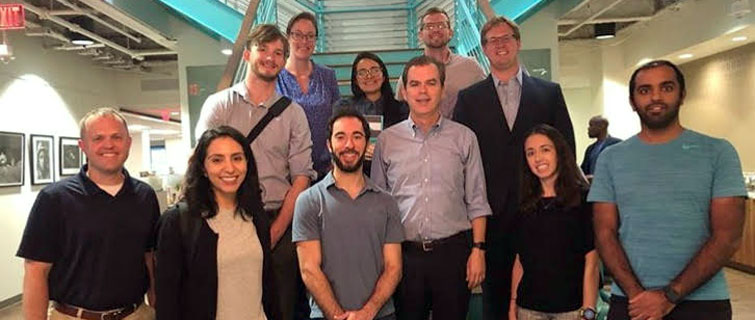
Consider the words “think tank,” and what comes to mind? A large, sealed chamber where people come to … “think?”
It’s not exactly an inviting image. And the farther one travels from Washington, D.C., and a few other major cities where think tanks are a more common part of the cultural landscape, the more inscrutable—and suspect—their work becomes. For example, a study last year on Americans’ perception of U.S. think tanks by the British firm Flint found that only 50 percent of Americans know what a think tank does. And unsurprisingly, given this lack of knowledge, only 20 percent trust what think tanks have to say.
“Think tanks play an essential role in generating policy ideas,” the study said. “But without effective public engagement around these ideas, the risk is that they will have no real-world impact.”
Breaking the Mold
Twenty years ago, New America (then called the New America Foundation) was created to break the mold of the conventional think tank. In order to have that “real-world impact” and a reach extending beyond academics and policymakers, the D.C.-based nonprofit advocated for thinking and doing—what it calls “thinking plus.” Now, it is looking to technology-enhanced communications and outreach to tell its story to a new generation.
“The perception of a think tank is the ‘ivory tower’—reflective, research-based, highly intellectual, research-driven, but traditionally quite insular,” said Meg Cohen, assistant dean for Georgetown University’s master’s programs in Marketing & Communications. “New America positions itself as a new kind of think tank that not only does the intellectual, research-driven, reflective work, but also draws insights from the real world in tangible, action-oriented ways.”
For example, the nonprofit’s Corporate Accountability Index looks at how effectively large internet and telecommunications companies meet their responsibility to support freedom of expression and other human rights. The Center on Education and Skills at New America (CESNA) leads a $4.5 million multi-partner effort to expand youth apprenticeship programs. The nonprofit’s Work, Workers, and Technology Program organizes “ShiftLabs” in various cities to prepare local and national leaders for the impact of automation on the workforce. And New America co-founded a Public Interest Technology University Network (PIT-UN) with Georgetown University and several other higher education institutions to bridge the gap between technological development and people’s day to day lives.
“We’re preparing people—and cities—for automation,” Molly Martin, director of New America Indianapolis, says in the group’s latest annual report. “It’s not just truck drivers or someone working on a factory floor; no matter what your job is, everyone is going to have to make a shift in how they earn a living.”
‘Finding the Right Tool’
Businesses are making a shift, too. In order to compete in today’s fast-paced, global markets, companies can no longer take a “one-size-fits-all” approach to communicating with customers. And the same is true for nonprofits like New America, which is trying to broaden its base of support by customizing its marketing efforts for different audiences.
At New America, “finding the right tool for the task and the audience is a big deal,” said Maria Elkin, the think tank’s deputy director of communications. For example, a highly technical paper on cyber security would be marketed differently to researchers, members of Congress, and the general public.
“Finding the right tool” also means that most everyone at New America—not simply marketers and public affairs specialists—needs to be invested in its communications strategy. As Ian Wallace, director of New America’s Cybersecurity Initiative, put it: “Running a think tank program is itself a form of communication.”
That emphasis on communication, both inside and outside the organization, might seem natural for a think tank, which exists, in part, to influence policy and public opinion. But it applies to other industries as well. At a recent New America site visit hosted by New America’s head of development Meredith Hanley, Cohen and students from Georgetown’s graduate programs in public relations, cybersecurity, journalism, and applied intelligence learned about how technology is changing the way all organizations communicate.
As machines take on more sophisticated computational, transactional tasks, workers in all sectors will need to develop the kind of integrated, interdisciplinary skills that still are unique to humans. And one of those skills is explaining their work to multiple audiences.
“With the advancement of technology, and transactional work being taken over by automation, the importance of effective communications and getting buy-in for ideas is a critical skill, not just for those in the communications field, but in every industry,” Cohen said. “The future of work will center more on effectively managing change, which requires strong communications.”
